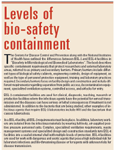Stakeholders seek role in Plum Island solution
Plum Island, N.Y. — The fate of Plum Island's aging research facility hangs in the balance as the government mulls scrapping the laboratories and DVM leaders argue the nation needs higher-level biocontainment capabilities.
PLUM ISLAND, N.Y. — The fate of Plum Island's aging research facility hangs in the balance as the government mulls scrapping the laboratories and DVM leaders argue the nation needs higher-level biocontainment capabilities.
While the Department of Homeland Security (DHS) solicits bids to replace the Plum Island Animal Disease Center with a new biological and agro-defense facility, veterinary stakeholders remain split on support for the current locale. A collective push, however, exists to create at least one Bio-Safety Level 4 (BSL-4) facility in the United States, capable of containing highly infectious and exotic agents. Plum Island, roughly a mile off Long Island in New York, ranks as the nation's only research facility authorized to study foot-and-mouth disease, yet it's laboratories are graded BSL-3.
When it comes to beefing up the nation's defense against emerging zoonotic infectious agents, the Plum Island facility doesn't cut it, critics say. Dr. Larry Heider favors a new facility off the island, currently accessible only by helicopter or ferry. Such a remote location hinders research activities as well as rebuilding efforts, he says.
"I think even if they upgrade the current site, it won't be satisfactory," says Heider, executive director of the Association of American Veterinary Medical Colleges. "The fact that there's one BSL-4 laboratory to be used for animal pathogens and that's in Canada does not speak well for this country."
AVMA involvement
United States Department of Agriculture (USDA) officials say they're aware of the need for expanded testing and evaluation facilities. Yet in an effort to move things along, the American Veterinary Medical Association (AVMA) has spearheaded a coalition of stakeholders charged with tackling the issue.

Levels of bio-safety containment
When it comes to moving off the island, Dr. Michael Chaddock hears mixed reviews. Roughly 200 scientists including veterinarians with USDA's Animal and Plant Health Inspection Service work at the current site. Abandoning it means ending more than 50 years of animal disease research on Plum Island and the jobs associated with it.
"I think we all realize is that an updated facility is needed," says Chaddock, director of the AVMA Governmental Relations Division. "We don't have a dog in the fight about where a new facility might be located."
Limited shelf life
To make that determination, DHS plans to conduct a study to identify key components to the new facility as well as a cost/benefit analysis, playing off President Bush's $23 million budget request for the design and initiation of the new facility. Rob Heckert, with USDA's Agricultural Research Service, has no insight into the relocation process. The building's viable and sound infrastructurally, but in 50 years, it will be obsolete, he says.
Revamping the current structures would be expensive, considering the logistics of moving supplies and workers onto an island.
"No matter what you're doing, it's more costly on an island," Heckert says. "It's like a little city out there because it has to be, with a fire department, waste disposal and fuel stations. On the mainland, you have the benefits of using another city's infrastructural support."
Weighing in
For now, the Plum Island Animal Disease Center remains intact. It will take years for the allocation of funds to come through and concrete plans to materialize, experts say. While congressional representatives and New York leaders push to maintain Plum Island's laboratories, Dr. Bennie Osburn, dean of the University of California-Davis (UC Davis) veterinary school, says it makes sense to build much-needed BSL-4 sites near educational institutions. Costs for such projects range from $400 million to $700 million, says Osburn, who examined expenses associated with BSL-4 laboratories as part of a National Academies of Sciences report.
Osburn votes to build such a facility in California, near UC Davis. The United States needs more than one BSL-4 facility, he adds.
"These facilities need to be positioned close to academic centers," Osburn says. "We bring in 60 percent of the imported food into the United States from our large ports. It's critical we get a BSL-4 site located here."